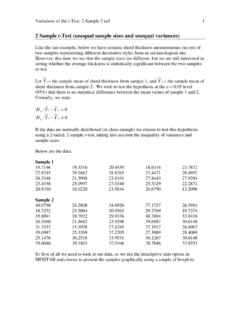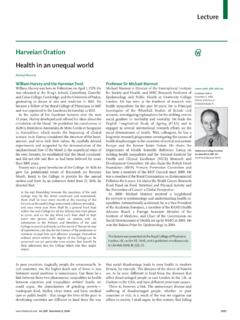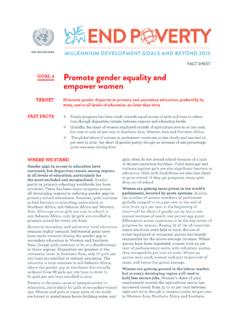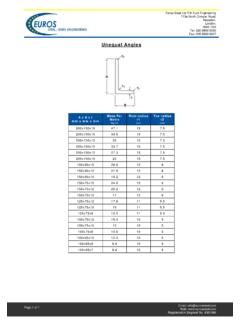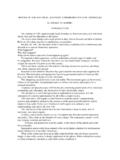Transcription of Mital C. Shingala et. al. / International Journal of New ...
1 Mital C. Shingala et. al. / International Journal of New Technologies in Science and Engineering Vol. 2, Issue 5,Nov 2015, ISSN 2349-0780 Available online @ 22 Comparison of Post Hoc Tests for unequal Variance Mital C. Shingala Assistant professor Shree Commerce & Shree College of Management, Varachha Surat-395006 Gujarat India Dr. Arti Rajyaguru Professor Department of Statistics Veer Narmad South Gujarat University, Udhana Magdalla Road, Surat- 395007 Gujarat India Abstract: One way ANOVA is performed only when the assumption of homogeneity of variance hold.
2 However, it is a robust statistic that can be used when there is a deviation from this assumption. The problem of test any differences in population means when both variances and sample sizes are unequal is called The Behrens-Fisher problem . In the literature associated with the problem of Behrens-Fisher, there have been some solutions proposed since the 1930 s. For example, Fisher (1935 and 1941), Welch (1947), Aspin (1948), Cochran and Cox (1950), Qin (1991) and Jing (1995) have proposed different solutions.
3 In this paper we have compared post hoc tests for unequal population variances for easy application purpose. Keywords: Multiple Comparisons, Post-Hoc Test, unequal Variance 1. INTRODUCTION: When there are K independent sample from k different populations, the experimenter is interested in testing the omnibus Null hypothesis Ho: 1= 2=..= k and determine a possible alternative. Interest often centers on pairs of means. The risk of a Type I error on a single contrast is known as the per comparison error rate.
4 The complete pair wise contrast together constitutes a family, in that if the omnibus null is true, then all pairs must be equal. Conversely, if any pair is not equal, the omnibus null must be false (Games & Howell, 1976). Ideally, an ANOVA is performed only when the assumption of homogeneity of variance holds. However, because it is a robust statistic that can be used when there is a deviation from this assumption. When the design involves unequal variances, there are several post hoc procedures, including Games-Howell, Tamhane T2, Dunnett T3 and Dunnett C.
5 None of the tests are exact tests, but the Tamhane T2, Dunnett T3 and Dunnett C are conservative procedures. (De Muth, 2006). The problem of the comparison means of two populations on the basis of two independent samples from respective populations with unequal variances has been studied for many years and there is a sizable literature. Historically, this problem has come to be known as the problem of Behrens-Fisher. With unequal n of six and up, only the Behrens fisher statistics provided satisfactory control of both the family wise rate of type 1 errors and type 1 error rate on each contrasts.
6 Mital C. Shingala et. al. / International Journal of New Technologies in Science and Engineering Vol. 2, Issue 5,Nov 2015, ISSN 2349-0780 Available online @ 23 In the literature associated with the Behrens-Fisher problem, there have been some solutions proposed since the 1930 s. For example, Fisher (1935 and 1941), Welch (1947), Aspin (1948), Cochran and Cox (1950), Qin (1991) and Jing (1995). Tests are proposed based on these solutions.
7 Games and Howell (1976) is based on Welch solution to the Behrens-Fisher problem, Dunnett C (1980) is based on Cochran's (1964) solution to Behrens-Fisher problem, Dunnett T3 (1980) is based on Sidak (1967) and Tamhane T2(1980) procedure based on the Welch-type degree of freedoms adjustment in the Dunn Sidak. These procedures control the overall risk of a type I error experiment wise at approximately the nominal significance level and have the best statistical power among the alternatives. Simulation studied by Dunnett(1980b) found that the Tucky Kramer procedure is sensitive to unequal variances and several approximate solutions for handling unequal variances were proposed, Games and Howell (1976),Tamhane T2 (1977), Dunnett T3(1980) and Dunnett C (1980) (Wilcox(1987)).
8 When treatment variances are unequal , the pooled estimate of variance cannot be used to calculate the standard error of the comparison. For all pair wise comparisons of means, these methods are used (Day &Queen, 1989). In this paper, we have considered the comparison and hence application of conservative tests when population variances are different. 2. CONSERVATIVE TESTS: Conservative tests can be classified on the basis of their assumptions of variance and sample sizes as follows: Conservative Post HocTestsPARAMETRICTEST Equal Variance & Equal Sample SizeTuckySnkDunnettDuncanREGWQREGWFE qual Variance & unequal Sample SizeFisherScheffeDunnettTucky KramerBonferroniSidak Hochberg GT2 GabrialUnequal Variance & unequal Sample Size Games HowellDunnett T3 Dunnett CTamhane T2 NON-PARAMETRIC TESTBy Adjusting P ValueBonferroniHolmHolland & CopenhaverHommelHochbergRomEqual Sample SizeNemenyiDunn controlSteel DwassSteel ControlUnequal Sample SizeDunn PairwiseDunn ControlMital C.
9 Shingala et. al. / International Journal of New Technologies in Science and Engineering Vol. 2, Issue 5,Nov 2015, ISSN 2349-0780 Available online @ 24 Hypothesis is same for all the tests as given below. Ho: i = ,1 Vs. H1: i j for at least for one pair. Along with the assumption related to variances and sample size mentioned in the above figure, other common assumptions are 1. The observations in each group are independent. 2. The observations are normally distributed.
10 3. It requires a significant F for ANOVA. GAMES HOWELL TEST (1976): The Games-Howell (GH) procedure is an extension of the Tucky Kramer test. GH method gives the best performance for pair wise comparisons. It may be too liberal when sample sizes are small and therefore recommend when the sample sizes are greater than five (Toothaker, 1991). Along with the assumptions given earlier, in each group we must have at least 6 observations. If the omnibus null is true, then all pairs must be equal. Conversely, if any pairs are not equal, the omnibus null must be false (Games &Howell, 1976).
